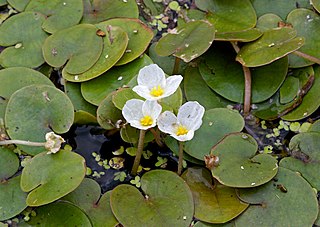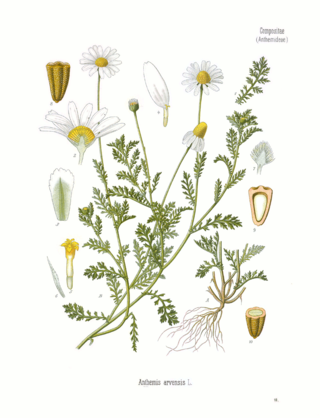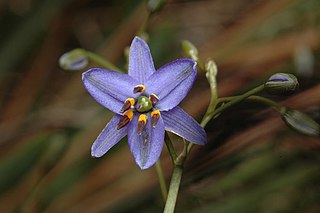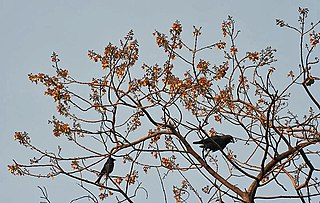
Vallisneria is a genus of freshwater aquatic plant, commonly called eelgrass, tape grass or vallis. The genus is widely distributed in tropical and subtropical regions of Asia, Africa, Europe, and North America.

The water-plantains (Alismataceae) are a family of flowering plants, comprising 20 genera and 119 species. The family has a cosmopolitan distribution, with the greatest number of species in temperate regions of the Northern Hemisphere. Most of the species are herbaceous aquatic plants growing in marshes and ponds.

Lycopodium clavatum is the most widespread species in the genus Lycopodium in the clubmoss family.

Hydrocharis is a genus of aquatic plants in the family Hydrocharitaceae described as a genus by Carl Linnaeus in 1753. It is widespread across much of Europe and Asia, plus a few scattered locations in Africa. It is also reportedly naturalized in parts of North America.

Symplocos is a genus of flowering plants in the order Ericales. It contains about 300 species distributed in Asia and the Americas. Many species grow in humid tropical regions. This is sometimes considered to be the only genus in family Symplocaceae. Plants in this family are shrubs and trees with white or yellow flowers. The oldest fossils of the genus date to the lower Eocene of Europe and North America, with the genus being present in Europe as late as the Pliocene. Fossil seeds of †Symplocos granulosa are frequent in sediment rock layers of the Late Oligocene to the Late Miocene of Denmark, Germany, Austria and Poland. The fossil seeds are very similar to the seeds of the extan southern Chinese species Symplocos glandulifera and Symplocos sulcata. Fossil seeds of †Symplocos paucicostata are known from the Middle Pliocene sediment rock layers in Reuver, the Netherlands and from the Late Pliocene sediment rock layers in northern Italy. The fossil seeds are very similar to the seeds of the extant East Asian species Symplocos paniculata

Alangium is a small genus of flowering plants. The genus is included either in a broad view of the dogwood family Cornaceae, or as the sole member of its own family Alangiaceae. Alangium has about 40 species, but some of the species boundaries are not entirely clear. The type species for Alangium is Alangium decapetalum, which is now treated as a subspecies of Alangium salviifolium. All of the species are shrubs or small trees, except the liana Alangium kwangsiense. A. chinense, A. platanifolium, and A. salviifolium are known in cultivation.

Anthemis arvensis, also known as corn chamomile, mayweed, scentless chamomile, or field chamomile is a species of flowering plant in the genus Anthemis, in the aster family. It is used as an ornamental plant.

Dianella is a genus of about forty species of flowering plants in the monocot family Asphodelaceae, commonly known as flax lilies. Plants in this genus are tufted herbs with more or less linear leaves and bisexual flowers with three sepals more or less similar to three petals and a superior ovary, the fruit a berry. They occur in Africa, South-east Asia, the Pacific Islands, New Zealand and Australia.

Nobuyuki Tanaka is an economic botanist at the Tokyo Metropolitan University, the Makino Botanical Garden in Kōchi Prefecture, Japan.

Gmelina is a genus of plants in the family Lamiaceae. It consists of about 35 species in Australia, New Guinea, New Caledonia, Southeast Asia, India and a few in Africa. Some species such as G. arborea have been planted and/or become naturalised in India, Africa and Australia. It was named by Carl Linnaeus in honour of botanist Johann Georg Gmelin.

Helicia is a genus of 110 species of trees and shrubs, constituting part of the plant family Proteaceae. They grow naturally in rainforests throughout tropical South and Southeast Asia, including India, Sri Lanka, Indochina, Peninsular Malaysia to New Guinea and as far south as New South Wales.

Alisma gramineum is a small aquatic plant in the water-plantain family. It has several common names including narrowleaf water-plantain, ribbonleaf water-plantain or ribbon-leaved water-plantain, and grass-leaved water-plantain. It grows in mud or submerged in shallow fresh or brackish water in marshy areas.

Halodule is a genus of plants in the family Cymodoceaceae described as a genus in 1841. It is widespread on tropical and semi-tropical ocean shores of all continents except Europe and Antarctica.
Alismaticarpum alatum is a fossil species of aquatic plants in the family Alismataceae. It is a form taxon created for winged fruits whose precise assignment to a genus is not possible. Fossil fruits of this species are known from the Oligocene of England.
Sagisma is a fossil genus of aquatic plants. It includes two species distributed in Oligocene and Miocene deposits of western Siberia.

Tofieldia is a small genus of flowering plants described as a genus in 1778. It is widespread across much of Europe, Asia, and North America.

Nechamandra is a monotypic genus of an aquatic plant family Hydrocharitaceae. The sole species is Nechamandra alternifolia. It is found in slow moving fresh water.

Blyxa is a genus of an aquatic plant of the family Hydrocharitaceae described as a genus in 1806.

Caldesia parnassifolia, is an aquatic species in the Alismataceae. It is found in slow-moving fresh water.

Burmannia is a genus of flowering plants long thought of as related to orchids, although more recent studies suggest closer affinities with either the Dioscoreales or the Melanthiales. The plants are herbs, partially autotrophic (photosynthetic) but also partially parasitic on soil fungi.


















